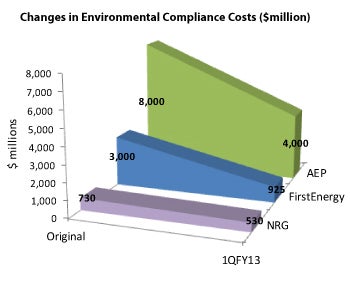The Cost to Meet Clean Air and Environmental Standards Comes Down (Again)
It is almost getting old for us to write about this … but it needs to be repeated.
As power plant pollution control projects continue, we are seeing – yet again — that the cost of meeting clean air standards, like the Mercury and Air Toxics Standards for power plants (MATS), has fallen.
Unfortunately, that hasn’t stopped some major power companies and other opponents from trying to undermine clean air and environmental standards.
However, this past quarter American Electric Power (AEP), NRG, and FirstEnergy each told their investors that their anticipated costs for meeting environmental standards dropped.
As you can see on our chart, AEP has lowered its estimated costs of following environmental standards by half, from a high of $8 billion down to $4 to $5 billion.
AEP was the top emitter of mercury, carbon dioxide, nitrogen oxide, and sulfur dioxide in 2011 among the top 100 power producers in the U.S.
And … AEP is a leader in the lawsuit to halt the Mercury and Air Toxics Standards.
As our chart also shows, FirstEnergy has lowered their cost estimate for complying with the Mercury and Air Toxics Standards by nearly 70 percent.
FirstEnergy’s estimate dropped from a high of $3 billion down to $925 million (which is $50 million lower than they estimated last quarter).
FirstEnergy was the sixth highest emitter of mercury in 2011 among the top 100 power producers, and is also challenging the Mercury and Air Toxics Standards in court.
The third company on our chart, NRG, has lowered its costs for complying with environmental standards from $730 million to $530 million, a reduction of more than 25 percent.
NRG was the fourth highest emitter of mercury in 2011 among the top 100 power producers.
These three companies are just a few of the power companies that have decreased their cost estimates for complying MATS and other environmental standards in recent years.
The tens of billions of dollars in expected health benefits from the Mercury and Air Toxics Standards has not decreased, though.
The Mercury and Air Toxics Standards will provide crucial emission reductions of toxic pollutants including mercury, acid gases, sulfur dioxide, and chromium.
It will save thousands of lives every year, prevent heart attacks and asthma attacks, and help protect the hundreds of thousands of babies born in America every year who are exposed to unsafe levels of mercury in the womb. And that is priceless.
It’s important that we keep in mind these misguided “sky is falling” claims about environmental compliance costs as EPA carries out its responsibilities under the nation’s clean air laws to address carbon pollution from power plants.
The time tested history of the Clean Air Act is quite the opposite – the sky is clearing, and at far less than the costs predicted by industry.













